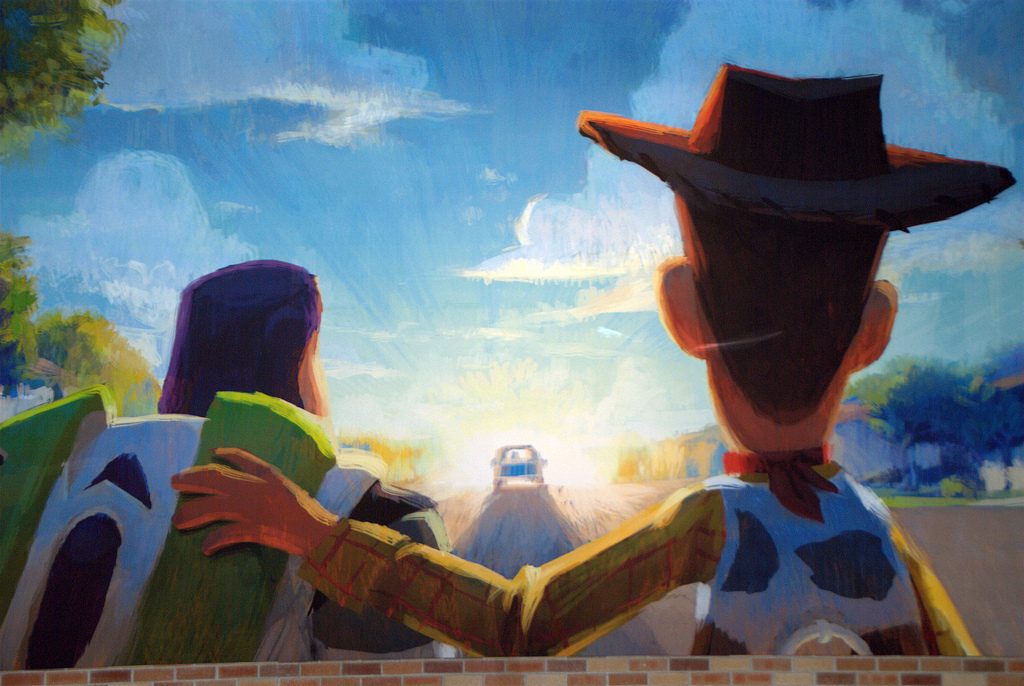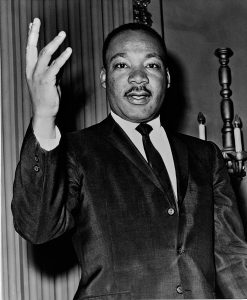Winner of the Fall 2018 StMU History Media Award for
Article with the Best Title
Best Article in the Category of “Cultural History”
“It felt like it had taken a lifetime to get to this point, and in a sense it had.”1
Most of us grew up in a world where toys came to life when Andy wasn’t looking, a world where the monsters in our closet were afraid of us, a world where houses could fly with balloons. Pixar movies have created a world of magic and infinite possibilities. They have brought life and authenticity out of technology. Pixar has created a cinematographic empire like no other. Their success was forged out of mistakes and struggles as well as passion, creativity, and determination. Pixar had to make mistakes in order to grow and create the stories we love today, and they did.
Pixar’s story really starts with three men: Edwin “Ed” Catmull, Steve Jobs, and John Lasseter.

Ed Catmull was turned down for a teaching position and felt he had landed a software development job with no future. Steve Jobs had been humiliated throughout Silicon Valley when Apple Computer, the company he founded, fired him.2 John Lasseter was fired from his dream job as a Disney animator for trying to introduce three-dimensional animation technology there. He was told that if it didn’t make movie production cheaper or faster, it wasn’t worth it.3 All of these men were at a low point in their lives when they became part of the group of people that eventually became Pixar. What brought them out of this uncertain part of their lives was a single goal: to change the way stories are told by pushing the boundaries of what computers can do in animation and graphics by creating the first computer-animated movie in history. These people became the foundation of Pixar Animation Studios.
Not commonly remembered is the company’s inception as the Computer Graphics Division for Lucasfilm, the movie studio behind the Star Wars franchise, beginning in 1979. Through a series of events, Steve Jobs ended up buying this small struggling division in 1986 for five million dollars. He also gave it its iconic name. At that point, the company was selling computer hardware with the Pixar Image Computer as their main product. Their increasingly dwindling revenue also consisted of producing commercials for companies such as Trident and Listerine.4 With their financial struggles, and no clear path into the future of movie-making, Pixar was created.
Pixar’s goal moved further out of reach as they fired one-third of the company in 1991. At that point, Pixar had only sold three hundred Pixar Image Computers. They then decided to stop selling hardware. The five million dollars it had cost Jobs to buy the company had turned into a $54 million money pit. Its only source of revenue, and future survival, was a contract with Disney to produce three movies. There wasn’t even a guarantee that they could make the movies. Nevertheless, the team decided to take a leap of faith into the unknown path of creating computer-animated movies.5
Money was tight and there was constant miscommunication between the Pixar team and Jobs. Jobs was in the middle of establishing NeXT, a computer company he started after Apple. This meant that he rarely appeared in the Pixar offices. The Pixar team felt Jobs did not understand what they needed, and Jobs felt that the Pixar team had no idea how to run a business. Lasseter and Catmull would put out an idea and Jobs would shut it down immediately: the only way was his way. Jobs was described as brilliant and inspirational as well as dismissive, condescending, and bullying. It was clear, Pixar could not survive under Jobs. He simply did not connect with the company leadership and staff, but the company could not survive without him either.6

From the year 1987 to 1991, Jobs attempted to sell Pixar three times. Catmull reflected on this time, saying, “Even if Pixar doubled in value, Steve told me, we still wouldn’t be worth anything.”7 Microsoft, Alias, and Silicon Graphics all tried to acquire the company, but Jobs never sold it. Despite taking millions of dollars of his own money just to keep it afloat, he could not sell. It was his way of saying that he had something other people wanted, something special, that Pixar was worth having, despite its flaws. Every time a company made an offer for Pixar, he acted insulted, suggesting that he believed Pixar was worth much more. It was only after critics predicted that an animated film would be a hit and that Disney signed with Pixar to make their movie, that Jobs gave Pixar one last chance.8
There emerged some hope, as they assembled an excellent but inexperienced team in 1992. Catmull and Jobs began to understand each other and collaborate, and the first computer-animated movie was in its beginning stages. Production of the movie began in early 1993. Their dream was so close that they could see it; their dream was becoming a reality. Their first movie blossomed from Lasseter’s simple idea, the story about a group of toys and a boy.9
Toy Story was going to create a revolution within the technology, art, animation, and entertainment fields. Because this was going to be their debut film under their “mentor” company Disney, Pixar story writers took every advice they gave them to heart. Disney animators were the experts, and they had the success Pixar craved. Disney perceived Woody, a toy cowboy and one of the movie’s main characters, as “too perky, too earnest.”10 An edgier Woody would create a better conflict and a better story. Or so they said.
November 19, 1993 came. It was also known as “Black Friday.” On this day, a mock-up of Toy Story was presented to Disney executives. Months of hard work had been dedicated to making this idea become a reality, and finally … Disney shut down the project. There would not be an animated movie until they fixed the script.
They had technology and talent, but the entire concept was just not right. Something crucial was missing. For the next couple of months Lasseter, Catmull, and the entire team worked every possible moment to rediscover the soul of the project. By this time, special effects were starting to enter mainstream cinematography, with movies such as Jurassic Park and Terminator 2. People enjoyed the manner in which technology enhanced the movie experience, and Pixar was ready to be part of this innovation wave.

The answer to their story problem was simple. They hit on the idea of a story of a boy and his toy cowboy. This experience taught them to trust their own abilities, to give Pixar its own character, and to do things the Pixar way.11
November 22, 1995. Toy Story was released to the world, to infinity and beyond.12
In total, Toy Story earned $362 million worldwide, it was a phenomenon. It had created an ingenious and creative new storytelling method. Now the graphics on the movie screen were perceived as having emotion and character. The movie had characters that had life in a way that was unprecedented from anything animators had done before. Pixar was able to create this emotional response because the overall theme was so human and relatable. With themes such as friendship, change, finding who you truly are, and your purpose in life, it is no surprise that though this movie was made for a young audience, it resonated with people of all ages. It was a masterpiece.13
The following year, Toy Story was nominated for three Academy Awards. John Lasseter received a Special Achievement Award. And Pixar announced its retirement from making commercials in order to focus on making more movies.
Due to its success with Toy Story, Disney pursued a partnership with Pixar. Shortly afterward, Pixar decided to open their company stock to the public. With this, they earned $140 million for the company. Pixar had accomplished something it had never done before; it was now a stable company.14
What started off as a constantly struggling company became an animation empire. Their stories have since touched the lives and hearts of people around the world. They’ve made us cry and they’ve made us laugh. Ed Catmull, Steve Jobs, and John Lasseter came together to change the world by creating the first computer-animated movie.
The rest is history.
- Edwin Catmull and Amy Wallace, Creativity, Inc.: overcoming the unseen forces that stand in the way of true inspiration (New York: Random House, 2014), 56. ↵
- David A. Price, The Pixar Touch: The Making of a Company (New York: Vintage Books, 2009), 8. ↵
- Bill Capodagli and Lynn Jackson, Innovate The Pixar Way: Business Lessons from the World’s Most Creative Corporate Playground (New York: McGraw-Hill, 2009), 31. ↵
- “Our Story,” Pixar, accessed August 31, 2018, https://www.pixar.com/our-story-1#our-story-main. ↵
- Edwin Catmull and Amy Wallace, Creativity, Inc.: overcoming the unseen forces that stand in the way of true inspiration (New York: Random House, 2014), 53. ↵
- Edwin Catmull and Amy Wallace, Creativity, Inc.: overcoming the unseen forces that stand in the way of true inspiration (New York: Random House, 2014), 51-52. ↵
- Edwin Catmull and Amy Wallace, Creativity, Inc.: overcoming the unseen forces that stand in the way of true inspiration (New York: Random House, 2014), 54. ↵
- Edwin Catmull and Amy Wallace, Creativity, Inc.: overcoming the unseen forces that stand in the way of true inspiration (New York: Random House, 2014), 53; “Our Story,” Pixar, accessed August 31, 2018, https://www.pixar.com/our-story-1#our-story-main. ↵
- Edwin Catmull and Amy Wallace, Creativity, Inc.: overcoming the unseen forces that stand in the way of true inspiration (New York: Random House, 2014), 54. ↵
- Edwin Catmull and Amy Wallace, Creativity, Inc.: overcoming the unseen forces that stand in the way of true inspiration (New York: Random House, 2014), 57. ↵
- Edwin Catmull and Amy Wallace, Creativity, Inc.: overcoming the unseen forces that stand in the way of true inspiration (New York: Random House, 2014), 57. ↵
- “Our Story,” Pixar, accessed August 31, 2018, https://www.pixar.com/our-story-1#our-story-main. ↵
- David A. Price, The Pixar Touch: The Making of a Company (New York: Vintage Books, 2009), 151. ↵
- Edwin Catmull and Amy Wallace, Creativity, Inc.: overcoming the unseen forces that stand in the way of true inspiration (New York: Random House, 2014), 60. ↵



201 comments
Alicia Guzman
First all, how interesting I had absolutely no clue that Steve Jobs was part of the big three members of the Pixar story. This article does a wonderful job of telling the story of Pixar Animation Studios. This story is a story of resilience and hope constantly re-emerging. I think it is very ironic that John Lasseter was fired from Disney for innovation yet he found a group helped found being asked to team up and work together.
Krystal Rodriguez
This was an amazing article. I belive it was so well written and has delved deep into the world that is pixar. I gre up watching disney and pixar films. They have shaped my life and have created this magical wolrd of escape for millions. I truly believe that these men have made something that no one in a million years could have come up with and the fact that they were in a low point of their lives truly motivates me and inspires me.
Andrew Petri
This article tells the story of how a group of struggling people took this company and turned it into one of the best selling studios to date. When I was a child, this company was already one of the biggest movie makers I knew of. Seeing how it was not an easy task to turn Pixar into a huge success, really makes me treasure their films even more now. I can say first hand, that Pixar truly did have an amazing impact on my life. It taught me one of my most important abilities, to allow my imagination to go to infinity and beyond.
Maya Mani
It’s shocking to hear how much Pixar was struggling in the beginning. As you were narrating the story, you did a great job at conveying Steve Job’s role in the company. He initially had the upper hand, and although was rejecting ideas and being a tough critic, he still had faith in the company. Toy Story is one of my favorite childhood movies, and I’m so proud at how far Pixar has come.
Tala Owens
It is incredible to read the story of how Pixar came to be. This article told the story really well. I would not even believe that Pixar had such a rough start up in the beginning. I did not know of the many doubts, project shut downs, and overall struggle to become the Pixar that they are today. Also, it is amazing they went through all of that and how successful Toy Story had become.
Christopher Metta Bexar
My very short review of this would be it does something most articles don’t. Make me want to learn more about the topic.
I knew about Pixar being a brainchild of Steven Jobs and that presumably Disney made Jobs a multi-billionaire again when they bought the company. I had read about Toy Story putting the firm on the media map as well as later talk that Toy Story 3 was a near lock for the Oscar for best animated feature because 1 was produced before the creation of the category ( which most of us know was created by Beauty & The Beast from Disney winning a nomination for Best Picture.
Jobs was not the first genius kicked out of a firm he had made huge. Nor the only man who created a second empire ( google Steve Wynn). But both men had the desire and talent to persevere in hardship.
Averie Mendez
This is an incredible article. I liked that you incorporated Pixar’s rough start into this piece, because, often times, we think that successful corporations like Pixar just came to be, like the ignition of a flame. However, it’s a lot more complex than that. It takes hard work, determination and the will to succeed, something Ed Catmull, Steve Jobs, and John Lasseter all possessed.
Ryan Estes
This article was incredibly well-written. I was engrossed in the story from the beginning to the end. I did not know that Steve Jobs was fired from Apple. I also didn’t know the whole history behind Pixar, and I love Toy Story, Ratatouille, Up, and Finding Nemo. One of my favorite quotes is a lengthy yet good one from Rocky Balboa: “Let me tell you something you already know. The world ain’t all sunshine and rainbows. It’s a very mean and nasty place and I don’t care how tough you are it will beat you to your knees and keep you there permanently if you let it. You, me, or nobody is gonna hit as hard as life. But it ain’t about how hard ya hit. It’s about how hard you can get hit and keep moving forward. How much you can take and keep moving forward. That’s how winning is done!” This mentality of the boxer is the entire feel of this wonderful article. Bravo!
Hali Garcia
I love articles like this. I find it fascinating how big names start out. Toy Story was one of my favorite movies when I was little and it is still one of my family’s favorites to this day. I actually did not know that Steve Jobs had a role in Pixar. This is a really interesting article and I am glad that it was written.
Ruben Basaldu
I think that the story of Pixar becoming what it is today is such a really rewarding story to tell as is anything where something comes from something small and be really big. I do really like that you wrote this article to explain the whole story of how Pixar came to be and Toy Story changing the game for movies. Also, I like this article because it talks about Steve Jobs and not many people knew that he had something to do with Pixar. Great article on an equally great topic.